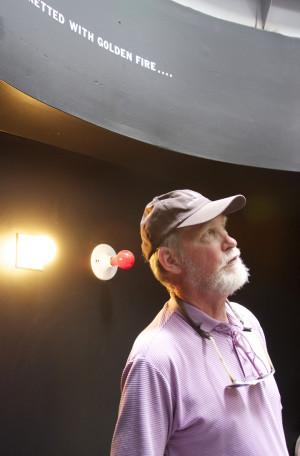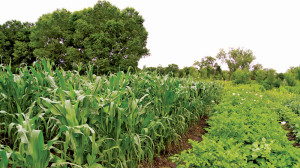By George Sibley
Two commemorations are worth noting this summer here in Central Colorado: the Wilderness Act is 50 years old, and this summer is also the 50th anniversary of the commencement of construction on the Fryingpan-Arkansas Project.
I mention them both here because it suits my unsubtle sense of irony. The Fry-Ark Project is about as contrary to the spirit of the Wilderness Act as one could imagine – a heavy-duty tampering with natural geography and hydrology in Central Colorado’s high country, that butts cheek to jowl against Wilderness Areas protected against any human tampering.
It is also accurate to say that, without passage of the act creating the Fry-Ark Project in 1962, a Wilderness Act would probably not have been passed in 1964. The whole complicated story behind that statement is too long for this column. Suffice it to say that, where federal public land and public works policy were concerned, more Congressional horsetrading happened in the 1960s than any time before or since. In a nutshell, America began a transition from the Old West, where conservation meant saving “wasted” resources (burning forests, rivers running unused to the ocean) for human uses, to a New West, where conservation meant protecting resources from consumption and collateral destruction. The Old West got a few more big water projects like the Fry-Ark in the 1960s (culminating in the Central Arizona Project in 1968), and the New West got its Wilderness Act. If I might drop in a bit of shameless self-promotion, anyone interested in that whole story – and it is a hell of a story – can find it in Water Wranglers, my book about the development of Colorado’s share of the Colorado River.
But it’s the concept of “wilderness” I want to take a look at here. Over the past 50 years, almost 110 million acres of wilderness have been designated in 758 Wilderness Areas, and there will be more. We should probably also consider the 52 million acres of National Park land as similarly protected, although it is managed differently. This idea of protecting areas from ourselves and what we sometimes euphemistically call “development,” is probably unique in human history. Kings and their nobles have always set aside preserves for their own use, but we don’t even allow our aristocrats to do development inside our official wildernesses.
Nonetheless, I have been, from the start, ambivalent about the wilderness vision. I am revisiting that ambivalence this year and finding it essentially unchanged. I think it is fine, on the one hand, that we are setting some largely “untrammeled” land aside. I do tend, however, to want to let wilderness define itself – as Phil Smith, Colorado River District manager, put it in 1961 wilderness testimony: “God Almighty made it that way. It will require no Act of Congress or administrative or executive order for it to retain its natural, primitive character … We could not change it if we wanted to.”
But on the other hand, I’ve never been comfortable with the virtuous piety that fuels so much of the wilderness movement, the dichotomizing and largely uncritical conviction that the works of nature are good, and (or thus) the works of humans are bad, and the best we can do is protect whatever remains of nature from ourselves. Mistakes we’ve made in our interactions with nature are obvious, and some of them long-term, but I don’t see writing ourselves off as a species incapable of doing better as a constructive step. I also can’t escape awareness that the wilderness movement is primarily a First World, middle- and upper-class movement, by, for, and of we humans who live richer, more comfortable and more globally expensive lives than any humans have ever before lived. We got ours, and we want to protect what remains unspoiled from those who don’t yet have theirs.
I encountered a fairly aggressive example of this piety recently in an op-ed piece in the Sunday New York Times – a publication that seems to vet its essays for their degree of acceptability to the nation’s intellectual status quo. The op-ed piece was about the Grand Canyon – I know, a National Park, not a Wilderness Area, but guided by similar rules. The essay expressed concern about two “developments” proposed in the vicinity of that national treasure. One, a gondola that would take tourists down to the confluence of the Colorado with the Little Colorado River; the other, a multi-faceted project to turn Tusayan village into a full-blown commercial tourist town. Both of them involve Third World Americans – Indian tribes – collaborating with out-of-town developers to get a better seat on the global tourism gravy train than their current roles as authentic furniture for the pre-modern scenery. I don’t like either proposed Grand Canyon area development, but I always feel a little shy about telling people who don’t suffer under my middle-class burden that they will be happier if they just stay more “natural” and forget about improving their material standard of living.
What really got to me in the article, however, was the aforementioned piety. In the first paragraph, the author, Grand Canyon boatman Kevin Fedarko, solemnly intoned that “at the end of each two-week, 277-mile journey down the Colorado River, someone would often come up to me and declare that the canyon was ‘America’s cathedral — a church without a roof.”’
Now, I’ve been through the Grand Canyon too, only once, but that was enough to know that I was not in a temple to any god to whom I wanted to give offerings. I was awed by it, yes; it was incredibly, occasionally outrageously, beautiful, and magnificent. If you are down there in the deadly heat of summer, as I was, it could be called “shock and awe” country.
But a long look at it – and two weeks down there in a raft is lots of time to look – pretty quickly reveals that this is the planet in destruction mode, the planet being reduced to sea-sand and gravel on a slow, stately, undeniably breathtaking but very elemental level. If this is a roofless church, it is home to a pretty ruthless god. Running through the Wilderness Areas and National Parks of the West, I am taken by the number of them that commemorate and celebrate the violent interactions of earth and its internal fire, and air and water and their solar fire. Spectacular, amazing, and definitely, each beautiful in its unique spectacular and amazing way. But America’s cathedrals, our true places of worship? Where do we think we are going, as a worshipful people?
Fedarko went on to observe that “nowhere else has nature provided a more graphic display of its titanic indifference to the works and aspirations of man,” and that “beneath those towering ramparts of unimaginably ancient rock, visitors are reminded that regardless of how impressive our achievements may seem, we are tiny and irrelevant in relation to the forces that have shaped the cosmos, and that we would thus do well to live humbly, and with a sense of balance.”
Now, really – in the era of anthropogenic climate change, is this statement even true? Are our “achievements” really so “tiny and irrelevant”? Shouldn’t we be taking ourselves and the impact of our works a little more seriously than that? Fedarko is almost countering his own argument – what’s wrong with a little gondola, another real-estate development, in the face of the titanic indifference of nature to our works? I think our historic – probably even prehistoric – problem has been Fedarko’s belief (well serviced by all our churches), that we are so tiny and irrelevant up against the works of God, the gods, nature, whatever you want to call those “cosmic forces,” that it is all as old Ralph Waldo Emerson said: that all of our “operations taken together are so insignificant, a little chipping, baking, patching, and washing, that in an impression so grand as that of the world on the human mind, they do not vary the result.”
Wrong; they do. But Emerson can be excused; he lived before we really got into the age of fossil fuels. Fedarko, along with all of the all-out climate-deniers, drillers, frackers, dig-we-musters have no such excuse; we are, unfortunately, not tiny and insignificant.
Rod Nash, who wrote so well about America’s relationship with wilderness – as a concept of imagination as well as a definable “reality” – also wrote briefly about “the gospel of ecology.” A “civil religion” was born in the 1960s that was “an intellectual fusion of scientific and what might be called theological ecology. The logic of the scientist blended into the intuition of the poet – Western analysis to Eastern mysticism.”
I think such a religion could be a positive force – but only if it were more firmly grounded in the disciplines of science than the intuitions of poetry, which may be too often blinded by beauty. And also: it should not be just another pious way of protecting First World “haves” against the strivings of the “have-nots.”
George Sibley writes from Gunnison, where he may be spending too much time thinking about water and the future.


